IDENTIFICATION PRIMER: FALCONS, KITES, AND NORTHERN HARRIER
Michael Tove
Three diverse groups of diurnal raptors: Falcons, Kites, and Northern Harrier superficially share common characters of long, narrow to pointed wings and long tails. From an identification perspective only, it is instructive to regard them as though a single group but beyond being superficially similar, the three groups are quite different.
FALCONS
This is the most wide-spread of the three groups in the Carolinas and the only one that occurs in all seasons. More closely related to parrots than hawks, this enigmatic group of birds includes some of the world's most celebrated species. Falcon identification is somewhat complicated by the fact that this group is extremely popular with falconers and on occasion, captive birds escape. Not only does this introduce foreign species into the equation, but also hybrids as these forms are commonly used in falconry.
Three species regularly occur in the Carolinas:
American Kestrel (Falco sparverius) — By far the most common falcon species in the Carolinas, this is also North America's smallest raptor. Unfortunately, over the past several decades, Kestrel numbers have decreased. The species is typified by strong sexual dimorphism but minimal plumage variation by age. American Kestrels differ from all other North American raptors in that they have two black vertical facial bars, one in front of the eye and one behind. When seen, this mark alone is diagnostic.

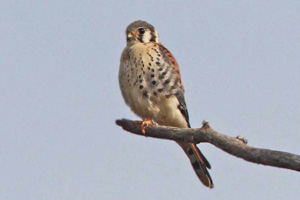
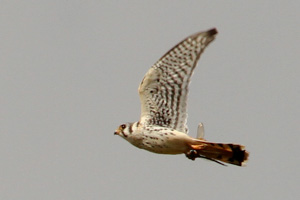
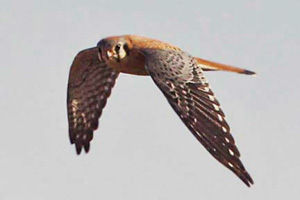
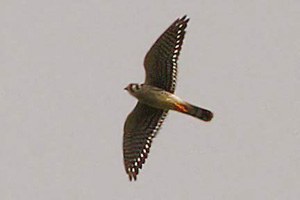
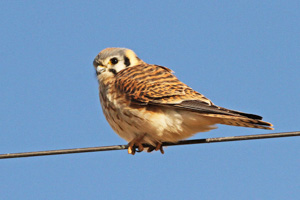
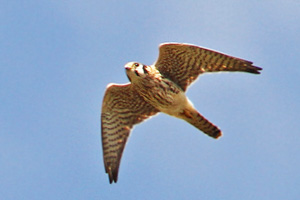
Male American Kestrels combine a rufous back and tail with slate-blue wing coverts (Figures 1, 2). The underparts of adults are cream-colored with black spots; whereas juvenile-plumaged birds have streaked chests. The back is marked with a smattering of thick black bars and the tail is tipped with a broad black sub-terminal band. In flight, the wings and tail are long and slender and the underwings are mostly white with thin black bars (Figures 3, 4). When lit from above, male Kestrels uniquely display a unique line of white spots along the trailing edge of the wing; a so-called “string of pearls” (Figure 5).
Female American Kestrels have uniformly rufous backs and upper wings (Figure 6). The back and tail are more heavily barred than males and the underparts densely streaked in reddish-brown. The underwings are light-colored but lack the “string of pearls” mark of the males (Figure 7).
In flight, Kestrels have a light and quick flap. Occasionally, they will be seen hovering on rapidly-beating wings over a field. When doing so, their body is typically oriented upward.
Merlin (Falco columbarius) — This relatively small falcon is heavier and proportionally shorter-winged than the American Kestrel. Predominantly a migrant and winter visitor, Merlins occur sparingly throughout our region most commonly along the coast.
The species exhibits strong sexual dimorphism and to a lesser degree, age-related plumage variations.
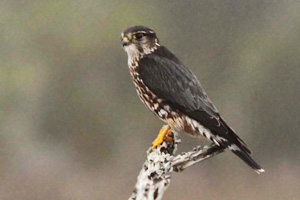
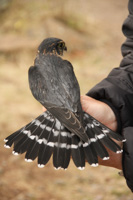






Adult males are slate blue on the back and are heavily streaked and barred beneath (Figure 8). They have a grayish face with a single vertical stripe through the eye. When seen, especially from above, the tail exhibits a bold pattern of narrow white bands on black (Figure 9). Immature males are browner and quite dark overall, but do retain a slate-colored back (Figure 10). Females and immature birds are browner overall, particularly on the back and crown (Figure 11). Adults are generally distinguished by having a stronger facial pattern but there is considerable overlap.
In all plumages, the under-parts are heavily streaked and barred and compared with American Kestrel, the under-wings are quite dark (Figure 12), particularly young birds (Figure 13). In flight, the wings are proportionally shorter and wider than Kestrel (Figures 13, 14) and can resemble the plumage of an immature Peregrine Falcon (Figure 14). Although Merlins are considerably smaller than Peregrines, judging size on birds in flight (without a fixed reference point) can be tricky.
Merlins in the east belong primarily to the nominate subspecies or Taiga Merlin (F. c. columbaris). However, a very pale race, the prairie or Richardson's Merlin (F. c. richardsonii) has strayed east (e.g., Kiptopeke, VA) and is at least theoretically possible. Richardson's Merlins, particularly non-adult males (Figure 15) are pale brown and light enough to cause potential confusion with female American Kestrel. However, the Merlin's single facial stripe, boldly barred black and white tail and lack of rufous coloration should be sufficient to separate it.
Merlins are strong, direct fliers, employing rapid wing beats. Although highly subjective, it is said that where Kestrels flail at the air with light rapid flaps, Merlins are “all business” and are seemingly always in a hurry. However, Merlins can drift along lazily, particularly when hunting dragonflies, a favorite, at least during fall migration. Merlins do not hover like Kestrels.
Peregrine Falcon (Falco peregrinus) — With a world-wide distribution, Peregrines are legendary for their high-speed dives (called “stoops”) that can attain speeds in excess of 240 MPH. Highly susceptible to pesticide poisoning, the eastern form (P. f. anatum) was brought to the brink of extinction in the 1970s. After widespread bans on DDT and a concerted collective effort of biologists and falconers (The Peregrine Fund), the species staged one of the most dramatic recoveries of any North American bird. In the Carolinas, they now occur year-round although relative abundance shifts from the western parts of our region during spring and summer where they breed, to the coast where wintering birds are more common. Two subspecies occur in the Carolinas.




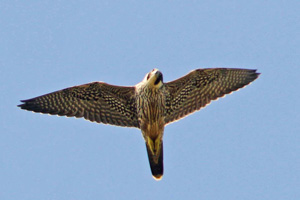

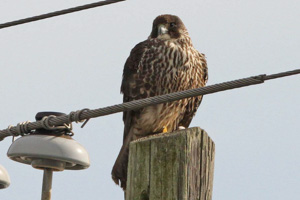
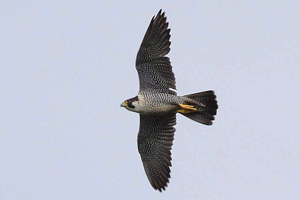
Adults are blue-gray backed with a bold black facial mask (Figure 16). The under-parts are white with a profusion of black horizontal bands that contrast against a pale chest (Figures 17, 18). The breeding form, P. f. anatum is technically an amalgam of many different races, the necessary consequence of the steps taken in the 1970's by the Peregrine Fund to resurrect the species from the brink of extinction. On average, adults are more heavily marked often with creamy-colored chests as compared with the pale Arctic form (P. f. tundrus), which the predominant wintering form.
Immature birds are brown backed with vertical brown streaks below (Figures 19, 20). The tundrus form (Figure 21) is relatively pale with a tan forehead. By comparison, form anatum (Figure 22) is darker with a dark forehead, broader facial mask and more heavily marked under-parts.
In direct flight, Peregrines are fast and powerful fliers, frequently on swept-back wings. They also soar and commonly thermal on flat, spread wings that can cause the sharply pointed tips to appear broad and slightly rounded (Figure 23). When they engage in their famous stoops, they fold their wings back and hurtle down at steep angles, looking like a swept-wing teardrop. At the bottom of the stoop, they can pull out with such speed that the air across their wings can produce a roaring sound.
Gyrfalcon (Falco rusticolus) — This high Arctic falcon is exceedingly rare anywhere south of Canada, even during winter, yet there are two records from SE Virginia and one unconfirmed (yet accepted) report from North Carolina. The world's largest falcon, Gyrs are as large, if not larger than Red-tailed Hawks. They occur in multiple color phases ranging from pure white to coal black but any Gyrfalcon that might occur in our area would most likely be brown or gray.
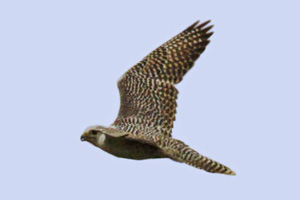
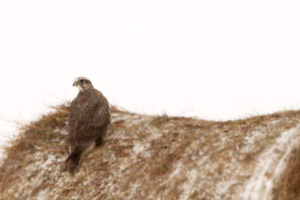
Adults have slate gray to brownish-gray upper-parts and white to light streaked or barred under-parts (Figure 24). The facial mask is usually indistinct or even absent. Immature birds (Figure 25) superficially resemble a large immature Peregrine but differ in overall shape and absence of a strong facial mask. Immature Gyrs can also superficially resemble a Prairie Falcon but are “colder” brown and lack the Prairie Falcon's diagnostic black axillars.
In flight, Gyrfalcons are remarkably powerful high speed birds, capable of accelerating to more than 70 MPH from a perch in a matter of seconds. They tend to be level fliers, overrunning prey rather than diving from above. When fully extended, the wings of a Gyr are broad and rounded. When pulled back to become more pointed, their wings are distinctly broad-based. In the northern Midwest and Great Plains (where they are regular), wintering Gyrfalcons are ambush-hunters, preferring to perch on an elevated structure and launch out at intended prey. The notion that they prefer to perch on the ground is misleading and results from the absence of any tall structure on their high Arctic breeding grounds.
Prairie Falcon (Falco mexicanus) — This western desert falcon is currently unrecorded from the Carolinas or any adjacent state. However, a well-documented recent record from the metro DC area (2017) suggests it could potentially occur.
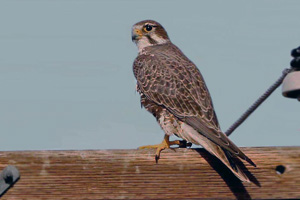
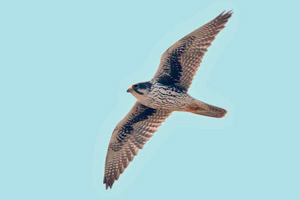
Roughly comparable in size to a Peregrine, Prairie Falcons are distinctly paler, sandy-brown with a thin dark brown line through the eye (Figure 26). There is no recognizable sex or age-related plumage variation. In flight, they have a distinct pattern of black axillars that extend outward along the greater under-wing coverts, forming a contrasting elongated black wedge that contrasts fore and aft with the rest of the under-wing (Figure 27). No other North American falcon is similarly patterned and any claim of Prairie Falcon from our region must reasonably include seeing this field mark.
Eurasian (Common) Kestrel (Falco tinnunculus) — This, the old world equivalent of our American Kestrel, has occurred in both New England and Florida. As such, it is a theoretical possibility for the Carolinas and even arguably has passed through both states unobserved.
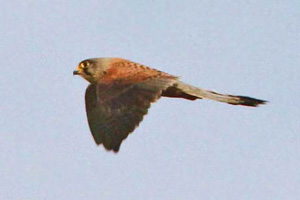
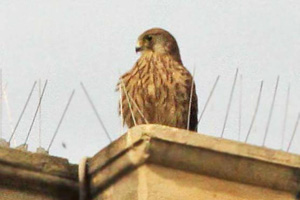
Compared with American Kestrels, Eurasian Kestrels are much larger and proportionally longer-tailed. Males have a gray head with a single black eye-line (not two) and a gray (not rufous) tail with a broad black terminal band (Figure 28). They also lack the American Kestrel's “string-of-pearls” along the trailing edge of the wing. Females somewhat resemble female American Kestrels except they have a single eye stripe, grayer head (Figure 29) and are much larger (intermediate in size between American kestrel and Peregrine Falcon.
Crested Caracara (Caracara cheriway) — Though technically related to falcons, this open country bird looks more like a long-winged Buteo than a typical falcon. None-the-less, it is included to round out the family. Although quite rare in our region, there are documented records from both North and South Carolina.
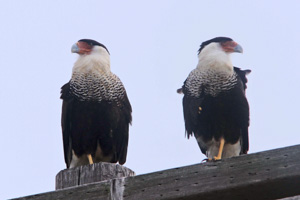
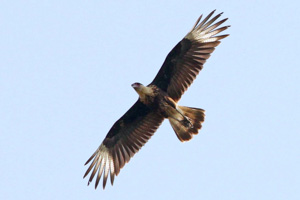
Compared with other members in the group, Caracaras (Figure 30) are large bird with heavy almost eagle-like bills that are red at the base and bluish at the end. They combine a dark crown and body with white chest and neck that is barred (adult) or streaked (immature). In flight (Figure 31) they have long broad wings that are mostly dark except for bold white outer-wing patches. The long tail is mostly white with fine dark barring and a bold black terminal band.
In flight, Caracaras fly with a raven-like slow wing-beat or glide and soar. This is completely different from the fast, stiff flapping of any other falcon.
KITES
Technically, this term refers to a very diverse group of raptors. Some species — specifically those under consideration here — have long, narrowly tapered wings with pointed tips. Others, such as Snail Kite, for which there are records from both Carolinas, superficially resemble Buteos, while the Double-toothed Kite of Central and South America looks remarkably like an Accipiter and the large kites of Eurasia (e.g., Black Kite) resemble small eagles with long notched tails.
Thus, the discussion here will be limited to North American kites that share long, pointed wings. Three species are known from the Carolinas of which two breed; none over winters.
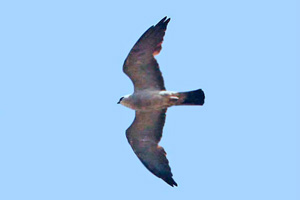
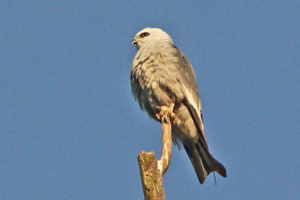
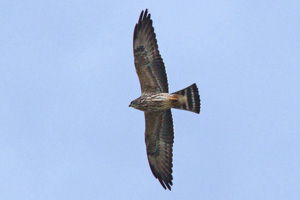
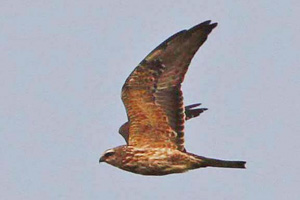
Mississippi Kite (Ictinia mississippiensis) — Intermediate in size between a Merlin and Peregrine, this is the most common kite species in the Carolinas. Regardless of plumage, the most distinctive feature is that the wings are narrow and pointed with the outermost primary being considerably shorter than the next two (Figure 32). That feature alone distinguishes this from any falcon — or for that matter, any other raptor with which it might be reasonably confused. The tails are long and slightly notched although this may not be evident if at all spread, even slightly.
Adults are the only raptor in our region whose body is uniformly slate-gray (Figure 33). The tail is black and the head paler, at times (strong light) appearing almost white. In flight, the upper-wings exhibit a distinctive tri-colored pattern of gray coverts, whitish secondaries and darker primaries. The secondaries on males are whiter than on females. At close range, the eye is blood red (Figure 33), a feature completely different from any falcon. First year birds are brown to gray-brown with heavily streaked underparts (Figure 34). They have dark unbarred flight feathers and a strongly barred tail, the combination of which is also uniquely diagnostic. Compared with immature Peregrine Falcons, young Mississippi Kites lack the facial mask and have broad black and white tail bars. Juveniles (Figure 35) are more uniformly brown than first summer birds.
In flight, Mississippi Kites are buoyant, agile fliers, frequently soaring on thermals. They commonly kettle in flocks that, at least during migration, can include hundreds or even thousands of birds.
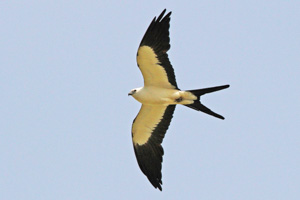
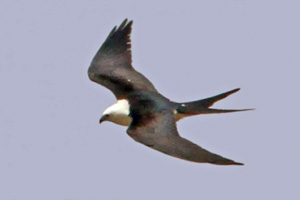
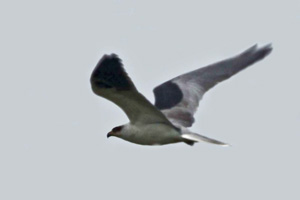
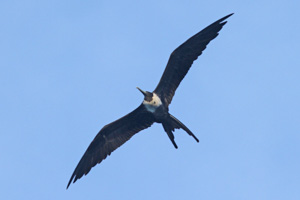
Swallow-tailed Kite (Elanoides forficatus) — So distinctive is this species that it's hard to imagine confusion with any other species in the group. Swallow-tailed Kites are large predominantly white birds with long black scissor-tails that comprise half the body length and contrastingly black flight feathers (Figure 36). From above, their wings and back are dark bluish-gray with a black wedge that extends along the leading edge of the wing from wrist to wrist (Figure 37). The only other species which superficially shares this latter feature is White-tailed Kite (Figure 38) but in that case, the tail shape and color differences are definitive. The only other species for which it might be confused is Magnificent Frigatebird (Figure 39), particularly an immature bird which has a mostly white underbody. However, the long beak of a Frigatebird is completely unkite-like and the underwings are entirely black. Swallow-tailed Kites have white under-wing coverts.
Remarkably buoyant in the air, Swallow-tailed Kites are commonly seen hawking insects which are then eaten while in flight.
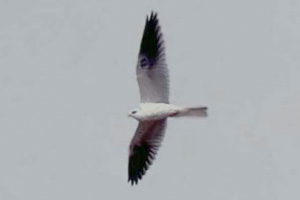
White-tailed Kite (Elanus leucurus) — Although exceedingly rare, this species is recorded from both North and South Carolina, probably representing north-bound strays from the small resident Florida population. Slightly larger than a Mississippi Kite, it is mostly white below with black outer-wing wedges beside black wrist spots (Figure 40) and pearl gray above with black shoulder patches (Figure 38). The outer-tail is white and, from above, pearl gray in the center. Adult Mississippi Kite has a black tail.
HARRIERS
Northern Harrier (Circus hudsonius) — This, the only Harrier species native to North America, is included here because its long wing and tail combination superficially resembles that of kites and falcons, and from an identification perspective, is most often confused with that group. Unlike kites and falcons, harriers exhibit significant plumage sexual dimorphism.
Harriers are lanky birds with long, narrow wings that are held in a strong V-shaped dihedral. They have long, slender tails and a bold white rump-patch. At close range, they can be seen to have an owl-like facial disk. This is used to assist them in locating prey in dense marsh and grass. The wing dihedral creates a bit of flight instability that results in some back-and-forth rocking as they quarter low over marshes. This rocking motion actually helps them triangulate in on prey, in particular with their sound location prowess.
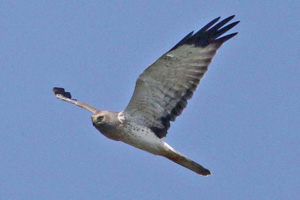
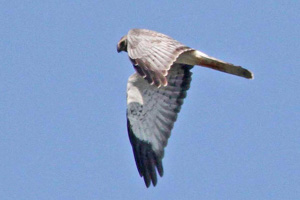
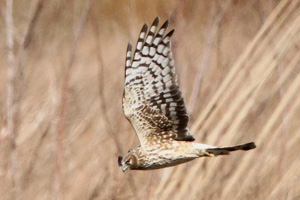
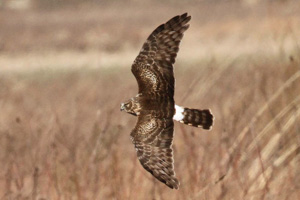
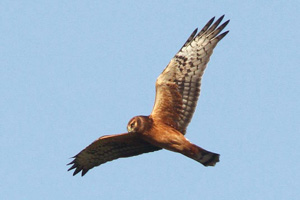
Adult males, colloquially called “gray ghosts” are pale birds with a pearl gray head and lightly spotted white underparts, white under-wings accented with black wing-tips (Figure 41). The back and upper-wings are pearl gray with bold black wing-tips, a white rump and pearl gray tail (Figure 42). Adult females are brown with tan belly streaking below (Figure 43) and brown with a strongly contrasting white rump from above (Figure 44). Immature birds resemble adult females but have a strong cinnamon wash on the underparts (Figure 45).
SUMMARY
All three groups (Falcons, Kites and Harriers) are easily seen in a year throughout the Carolinas. Those species listed as rare are, in fact, exceedingly rare, including yet unrecorded. Anyone who is fortunate enough to discover any of the rarer species is strongly encouraged to take meticulous notes in the field with the bird present, get photographs and get the word out to others. Not only does the latter help others enjoy the discovery, but it provides perhaps the best, if not the only way to adequately document a mega-rarity.

